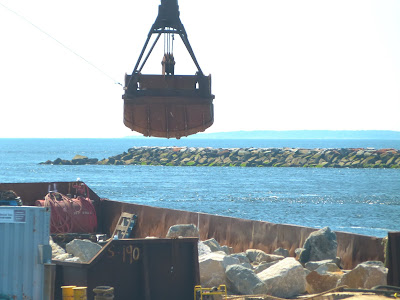I started this blog with the intention of just doing photo essays. Then I learned how to use the video on the digital camera. The videos are able to capture the action of the construction site better and are more exciting than the still photos. I have tried to strike a balance between photos and videos. I thought I would go back to photos for this post.
With this photo I used the stone blocks on the beach to frame the foreground of the photo.The barges came out on the dark side, one of the headaches of the strong contrasting lighting conditions.
In photography classes one is taught the "rules of thirds." This rule is based upon drawing two vertical lines that divided the frame (left to right) into thirds and two horizontal lines that divide it into thirds top to bottom. You position the subject of the photo at any of the four points the horizontal and vertical lines cross. In this photo I have violated that rule and placed the boom of the crane in the center. Normally, dividing the photo down the center with the subject ruins the composition. In this the case the two distant cranes, one on either side balances the composition and also gives a sense of visual depth to the image. This photo probably wouldn't have worked as well in color.
Again, in this photo the anchor post of the barge is dead center but the image works. The other two anchors post on the barge in the background help to balance the composition. The darker foreground and lighter (grayer) barge in background helps as well.
In this photo the excavator arm and crane boom lead the eye into the scene.
I like to capture photos of beachgoers with the construction equipment on the Salisbury jetty to show both co-exist side by side on the beach.
I like to experiment with different angles and perspectives. Both of these photos were taken from behind the sand dune and only the top of the tractor, crane, and dump truck are visible. The dune helps to convey a sense of place - the coastline. Neither photo would win a photo contest but both are effective at documenting the construction site.

















































